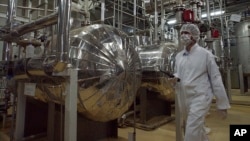
New satellite imagery of an Iranian military site that Israel apparently destroyed in October and that some Western analysts said was a nuclear facility shows that Iran made efforts to conceal the debris. Those efforts indicate the site contained something of value, the analysts told VOA.
The commercial satellite images from Maxar Technologies published Monday on the X platform by the Washington-based Institute for Science and International Security show the destroyed building known as Taleghan 2 at Iran's Parchin military base on November 6 and November 24.
An archive of Iranian nuclear documents seized by Israel from Tehran in 2018 and later shared by Israel with the institute included what the group has said were pre-2004 images of Taleghan 2, showing the building housing equipment used in nuclear weapons research.
The International Atomic Energy Agency has said Iran suspended an active nuclear weapons program in 2003. Iran has denied Israel's allegation that it has covertly continued that program.
Israel apparently struck Taleghan 2 in its October 26 aerial assault on Iran, according to Western media citing researchers who examined before-and-after commercial satellite images of the rectangular building, which had been built in a carved-out section of hillside.
The new images published by the institute show that by November 6, Iran had covered the demolished building with a makeshift horizontal structure and erected vertical security screens next to debris piles, shielding the site from being viewed from above and on the ground.
The images also show that by November 26, the vertical security screens had been removed, while the horizontal structure remained over the building and the debris piles remained visible around the site. The institute identified one pile as probably containing destroyed equipment.
In an interview with VOA, the institute's president, American physicist David Albright, said the resolution of the commercial satellite imagery was not high enough to identify what kind of equipment likely had been destroyed inside Taleghan 2. But he said the erecting of two vertical screens at the site for several weeks indicates that some of the debris was of a sensitive nature.
"I think Iran put up the screens because it was nervous that foreign intelligence agents could use a telescope from down the road to figure out what was in the debris," Albright said. "They later took down the screens probably because they had hauled away the sensitive stuff and wanted to make it easier to continue the cleanup process at the site."
Olli Heinonen, a researcher at the Washington-based Stimson Center and a former IAEA official who inspected Iran's Parchin base twice in the early 2000s, shared his observations of the latest satellite imagery with VOA in a separate interview.
"Even if the Iranians removed the most valuable equipment from Taleghan 2 for some reason before the October 26 strike, the building still would have equipment left, considering its purpose," Heinonen said. "Any valuable material in the rubble certainly could have been taken away."
Heinonen said the temporary vertical screens at the site may have been intended to conceal the debris not only from prying foreign eyes but also from Iranian dissidents and curiosity-seekers.
"It also is logical for authorities to clean up the site, so that the morale of Parchin's thousands of workers is not harmed by them seeing destruction caused by a foreign power," he said.
Israel initially said its October assault on Iran targeted aerial defense and missile production sites. It was the first major Israeli attack on Iran after more than a year of fighting that began with an attack by Iranian proxy group Hamas on the Jewish state and grew into a multifront conflict directly involving Tehran and its other regional proxies.
Netanyahu revelation
Speaking to Israel's parliament on November 18, Israeli Prime Minister Benjamin Netanyahu revealed that the October offensive also "harmed" what he called a "certain component" of the Iranian nuclear program, without elaborating. Taleghan 2 was the only site with an alleged link to that program identified by Western media as one of the targets of the Israeli operation.
Iran's U.N. mission in New York did not immediately respond to a VOA email, sent on Friday, asking whether the Taleghan 2 building was an undeclared part of the Iranian nuclear program.
IAEA Director General Rafael Mariano Grossi told a news conference on November 20 that the U.N. nuclear agency does not see Taleghan 2 as a nuclear site.
A November 15 report by U.S. news site Axios cited unnamed U.S. officials and unnamed current and former Israeli officials as saying it was an "active top-secret nuclear weapons research facility."
Grossi said the site "could have been involved in the past in some activities" of concern, but he added: "We don't have any information that would confirm the presence of nuclear material there ... [or] that would substantiate this idea that recently some activities [there] ... could be of relevance for us."
The lack of clarity on the equipment in the rubble of Taleghan 2 makes it difficult to assess the significance of the building's destruction to Iran, researchers told VOA.
Albright noted that Netanyahu described Israel as having "harmed" a component of Iran's nuclear program, rather than saying Israel severely damaged Tehran's bomb-making ability.
"Sometimes in a strike like this, the bomb doesn't damage every important piece of equipment. One piece is in a corner, survives and can be fixed later, or the Iranians have a replacement at some university or other military production site," Albright said.
Andrea Stricker, a nonproliferation researcher at the Washington-based Foundation for Defense of Democracies, said regardless of whether serious harm was done to nuclear weapons research at Taleghan 2, the significance of the strike is in the message that Israel apparently was sending.
"The message is that further attacks on more consequential nuclear sites are to come if Tehran does not halt such efforts," Stricker said.








